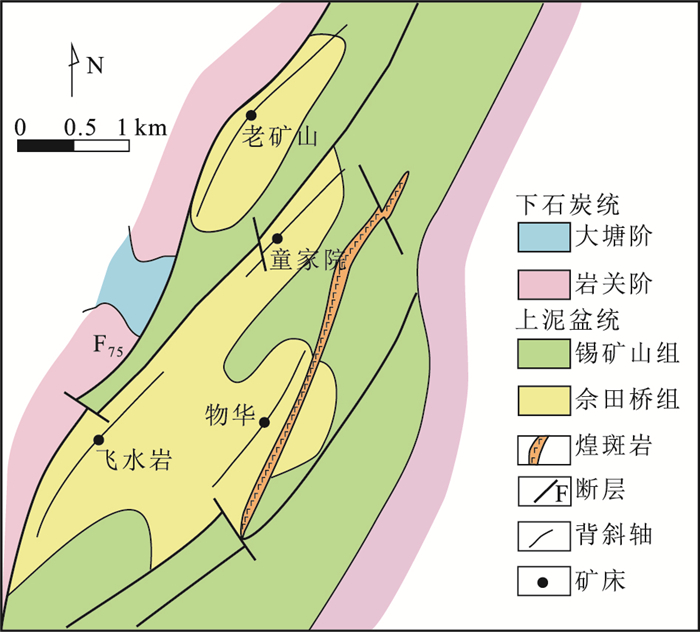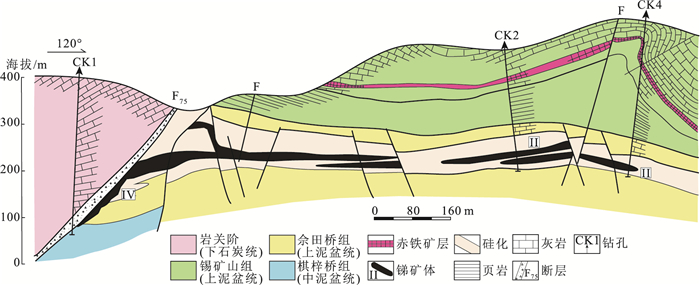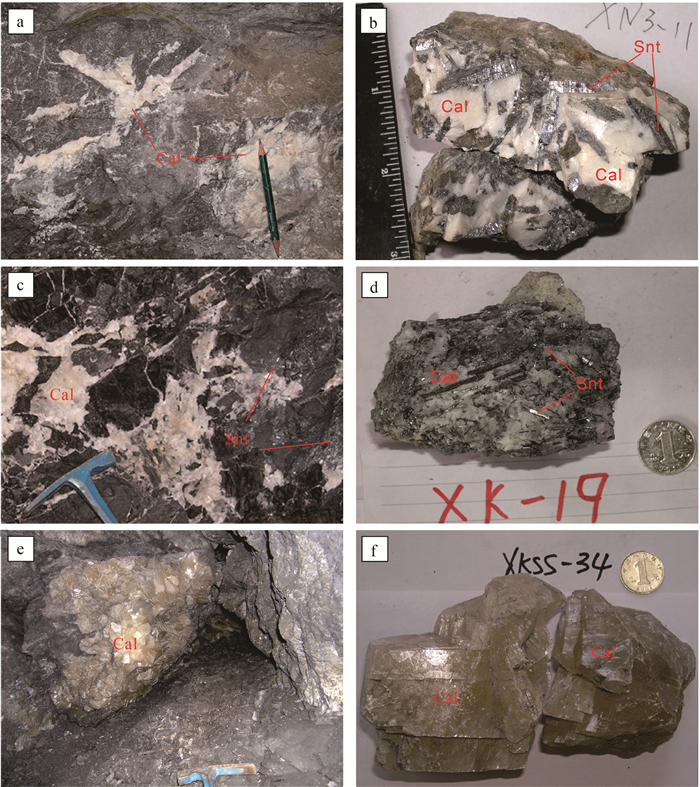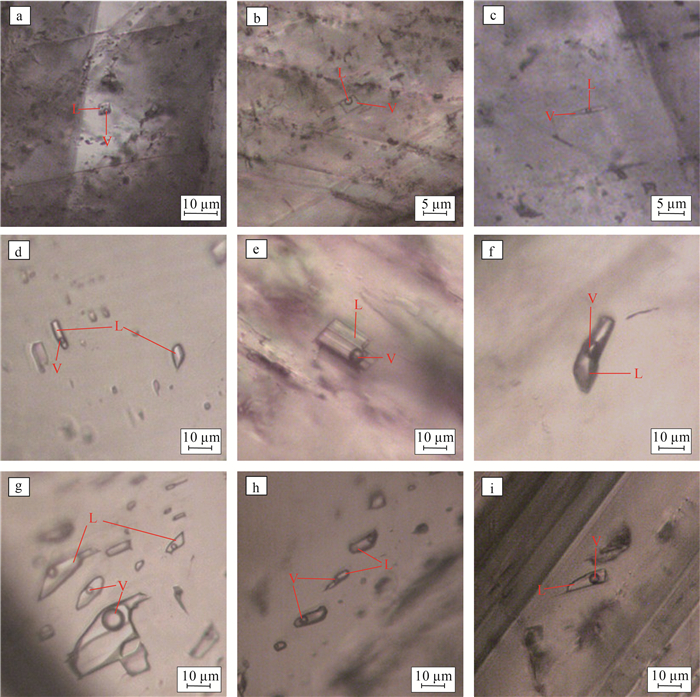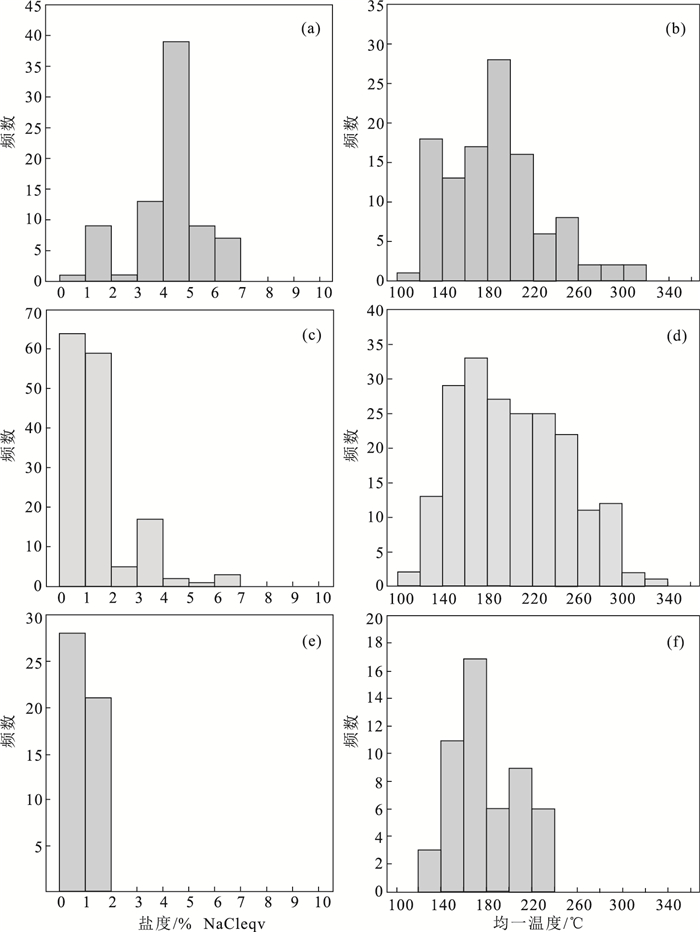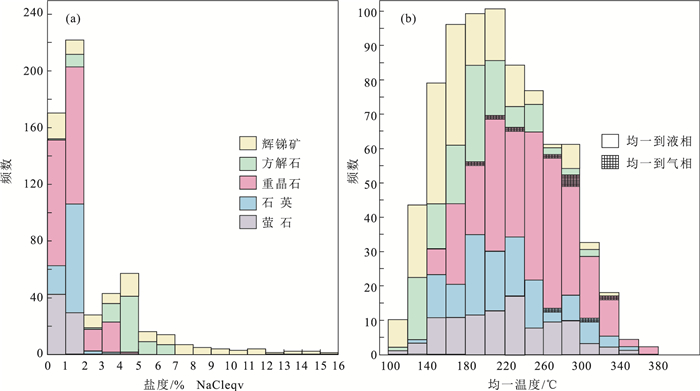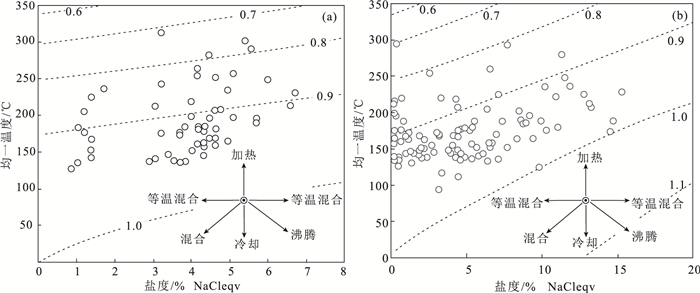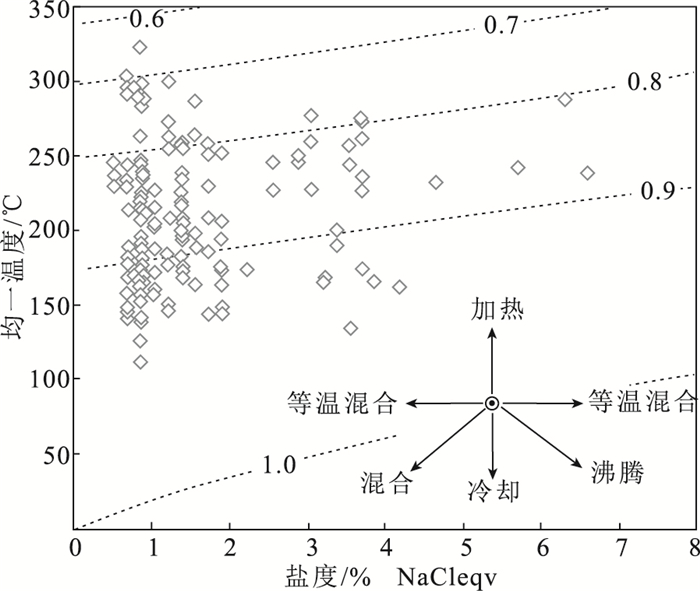The accumulation mechanism of giant ores in the Xikuangshan antimony deposit, central Hunan: Constraints from fluid inclusions hosted in calcite
-
摘要:
湘中锡矿山锑矿床目前研究程度已经很高, 但对该矿区锑矿石发生巨量堆积的原因仍不清楚。热液矿床巨量矿石的堆积过程, 实际上就是大规模流体汇聚并发生有效沉淀的过程, 因此, 对锡矿山矿区流体演化过程和沉淀机制的研究有助于解决其巨量矿石的堆积机制问题。锡矿山矿区方解石非常发育, 且与成矿关系密切, 是研究该区流体作用的理想对象。对该区不同期次方解石进行流体包裹体岩相学和显微测温研究, 初步刻画了该区流体演化过程和矿石沉淀机制。研究表明, 不同期次方解石中流体包裹体类型基本相同, 主要为Ⅰ型(纯液相包裹体)和Ⅱ型(富液相两相包裹体), 但流体包裹体的岩相学特征存在明显差异: 主成矿期流体包裹体不发育且个体小, 成矿晚期流体包裹体发育程度中等且个体较大, 成矿后流体包裹体非常发育且个体很大。流体包裹体显微测温分析显示, 该区经历了2次独立的成矿事件: 主成矿期成矿流体为中高温、中低盐度的热液, 这种热液有利于锑的大规模迁移, 矿石沉淀机制为流体混合作用; 成矿晚期流体为中温、低盐度热液, 这种热液中锑的浓度明显小于主成矿期, 矿石沉淀机制为冷却作用; 成矿后还存在一期热液事件, 其流体为一种低温、低盐度热液。锡矿山矿区矿石巨量堆积主要与主成矿期成矿作用有关, 该期成矿流体中锑的浓度高, 流体规模巨大, 且流体混合作用这种矿石沉淀机制非常有利于超大型锑矿床的形成。
Abstract:Although a lot of efforts have been made on the Xikuangshan deposit, the key scientific problem why such giant ores were accumulated in the narrow Xikuangshan area still remains unclear.The detailed investigation on the evolution of the ore-forming fluid and on the mechanism of its ore precipitation will be helpful for solving the above problem, since the giant ore accumulation in the hydrothermal deposit resulted from the convergence and effective precipitation of the large-scale hydrothermal fluid.Calcite is common in the Xikuanghan deposit and is closely related to antimony mineralization, thus it is an ideal mineral to study the mineralization process in the Xikuangshan ore district.Based on the researches on the petrography and microthermometry of fluid inclusions hosted in calcite, the fluid evolution process and ore precipitation mechanism are preliminarily depicted, and then the accumulation mechanism of giant ores in the Xikuangshan deposit is discussed.It is shown that, various calcites share similar fluid inclusion types, but their fluid inclusions display the distinct differences in view of petrography, the fluid inclusions hosted in those calcites of the early mineralization are rare in amount and small in size, the inclusions hosted in calcite of the late mineralization are relatively developed and relatively large in size, and the inclusions in the post-ore calcites are the most in amount and the largest in size.It was revealed that there are twice independent mineralization events happened in the Xikuangshan ore district.The early mineralization is characterized by the hydrothermal fluid with relatively high temperature and moderate salinity, which is beneficial to the large-scale migration of antimony, and the fluid mixing is responsible for the ore precipitation of early mineralization; the late ore-forming fluid is a kind of moderate-temperature and low-salinity hydrothermal solution, the antimony concentration in this kind of hydrothermal solution is significantly lower than that in the early mineralizing fluid, and the ore precipitation resulted from the fluid cooling.Moreover, there is another hydrothermal event after antimony mineralization with low-temperature and low-salinity solution.The giant accumulation of ore in the Xikuangshan ore district is mainly ascribed to the early mineralization, with high-concentration antimony in the ore-forming fluid and the giant flux of fluid, and the ore precipitation mechanism of fluid mixing in the early mineralization stage are favorable for the formation of the giant antimony deposits.
-
Key words:
- metallogenic mechanism /
- calcite /
- antimony deposit /
- superlarge ore deposit /
- Hunan Province
-

-
图 1 研究区大地构造位置(a, 据全国标准地图(审图号:GS(2022)4312号)修改)和湘中区域地质图(b, 据史明魁等,1993修改)
Figure 1.
图 2 锡矿山锑矿床地质图(据刘光模等,1983修改)
Figure 2.
图 7 锡矿山锑矿床成矿晚期方解石流体包裹体均一温度-盐度散点图(等密度线据Wilkinson,2001)
Figure 7.
表 1 锡矿山锑矿床方解石采集位置及产出特征
Table 1. The sampling locations and characteristics of calcites collected from the Xikuangshan antimony deposit
样号 采样位置 产出特征 主成矿期 XN3-9 北矿3中段 肉红色方解石 XN3-11 北矿3中段 方解石-辉锑矿型矿石 XN3-14 北矿3中段 方解石-辉锑矿型矿石 XN3-15 北矿3中段 方解石-辉锑矿型矿石 成矿晚期 XK-19 北矿6中段50#勘探线 石英-方解石-辉锑矿型矿石 XK-47 南矿25中段49运道 角砾岩中的方解石胶结物 XK-58 南矿19中段39采场 方解石-辉锑矿型矿石 XKS-41 南矿19中段 方解石-辉锑矿型矿石 XKS-A3 北矿童家院矿区 方解石-辉锑矿型矿石 XKS-A7 北矿童家院矿区 方解石-辉锑矿型矿石 XKW-8 北矿6中段 方解石-辉锑矿型矿石 成矿后 XKSS-29 南矿25中段西沿脉 晶洞方解石 XKSS-34 南矿25中段北沿脉 晶洞方解石 表 2 锡矿山锑矿床不同期次方解石流体包裹体显微测温结果
Table 2. Microthermometric data of fluid inclusions for different calcites in the Xikuangshan antimony deposit
样号 Tm/℃ 盐度/% NaCleqv Th-tot/℃ 主成矿期 XN3-9 -0.5~-4.1(23) 0.88~6.59(23) 111.8~234.1(31) XN3-11 -0.9~-4.0(21) 3.23~6.45(21) 139.2~273.4(33) XN3-14 -0.7~-4.2(19) 1.23~6.74(19) 127.1~313.8(26) XN3-15 -0.6~-4.1(16) 1.06~6.59(16) 123.8~225.3(23) 成矿晚期 XK-19 -0.4~-1.5(26) 0.71~2.57(26) 112.3~322.3(30) XK-47 -0.4~-0.6(6) 0.71~1.06(6) 121.9~186.2(14) XK-58 -0.5~-1.9(25) 0.88~3.23(25) 166.9~298.8(31) XKS-41 -0.5~-2.5(25) 0.88~4.18(25) 127.0~261.9(35) XKS-A3 -0.3~-4.1(26) 0.53~6.59(26) 126.2~309.1(32) XKS-A7 -0.4~-2.2(20) 0.71~3.71(20) 145.8~289.6(28) XKW-8 -0.4~-1.0(23) 0.71~1.74(23) 109.3~302.6(32) 成矿后 XKSS-29 -0.4~-0.8(25) 0.71~1.40(25) 128.6~237.3(24) XKSS-34 -0.2~-0.8(24) 0.35~1.40(24) 122.6~229.0(28) 注:括号内为流体包裹体的测试数量 表 3 锡矿山锑矿床不同期次流体的均一温度和盐度对比
Table 3. Comparison of homogenization temperatures and salinities of fluid in different stages in the Xikuangshan antimony deposit
成矿期次 矿物名称 均一温度/℃ 盐度/% NaCleqv 范围 平均值 范围 平均值 主成矿期 第Ⅰ阶段 石英 124~374 222(111) 0.5~3.9 1.24(89) 萤石 119~357 221(94) 0.5~1.6 0.93(71) 重晶石 142~366 244(262) 0.2~4.2 1.34(222) 第Ⅱ阶段 辉锑矿 112~325 177(154) 0.2~15.4 5.03(103) 方解石 112~314 186(113) 0.9~6.7 4.18(79) 成矿晚期 方解石 109~322 202(202) 0.5~6.6 1.61(151) 成矿后 方解石 123~234 166(55) 0.3~1.4 0.96(49) 注:括号内数字为流体包裹体测定数量;锡矿山主成矿期辉锑矿、石英、萤石、重晶石数据据Hu et al.(2018) -
[1] Borisenko A S, Obolensky A A. Concentration of ore-forming solutions as a factor of formation of superlarge deposits[J]. Geotectonica et Metallogenia, 1994, (Z2): 1-4.
[2] Chi G X, Diamond L W, Lu H Z, et al. Common problems and pitfalls in fluid inclusion study: A review and discussion[J]. Minerals, 2021, 11: 1-23.
[3] Fall A, Bodnar R J. Howprecisely can the temperature of a fluid event be constrained using fluid inclusions? [J]. Economic Geology, 2018, 113(8): 1817-1843. doi: 10.5382/econgeo.2018.4614
[4] Gaëtan L, Stanislas S, Laurent G, et al. Deciphering fluid flow at the magmatic-hydrothermal transition: A case study from the world-class Panasqueira W-Sn-(Cu) ore deposit (Portugal)[J]. Earth and Planetary Science Letters, 2018, 499: 1-12. doi: 10.1016/j.epsl.2018.07.012
[5] Hagemann S G, Lüders V. P-T-X conditions of hydrothermal fluids and precipitation mechanism of stibnite-gold mineralization at the Wiluna lode-gold deposits, Western Australia: Conventional and infrared microthermometric constraints[J]. Mineralium Deposita, 2003, 38: 936-952. doi: 10.1007/s00126-003-0351-6
[6] Hall D L, Sterner S M, Bondar R J. Freezing point deporession of NaCl-KCl-H2O solutions[J]. Economic Geology, 1998, 83: 197-202.
[7] Hu A X, Peng J T. Fluid inclusions and ore precipitation mechanism in the giant Xikuangshan mesothermal antimony deposit, South China: Conventional and infrared microthermometric constraints[J]. Ore Geology Reviews, 2018, 95: 49-64. doi: 10.1016/j.oregeorev.2018.02.005
[8] Kerkhof A M V D, Hein U F. Fluid inclusion petrography[J]. Lithos, 2001, 55(1/4): 27-47.
[9] Krupp R E. Solubility of stibnite in hydrogen sulfide solutions, speciation, and equilibrium constants, from 25 to 350℃[J]. Geochimica et Cosmochimica Acta, 1988, 52: 3005-3015. doi: 10.1016/0016-7037(88)90164-0
[10] Liu P, Mao J R, Jian W, et al. Fluid mixing leads to main-stage cassiterite precipitation at the Xiling Sn polymetallic deposit, SE China: evidence from fluid inclusions and multiple stable isotopes (H-O-S)[J]. Mineralium Deposita, 2020, 55(6): 1233-1246. doi: 10.1007/s00126-019-00933-0
[11] Mernagh T P, Leys C, Henley R W. Fluid inclusion systematics in porphyry copper deposits: the super-giant Grasberg deposit, Indonesia, as a case study[J]. Ore Geology Reviews, 2020, 123: 103570. doi: 10.1016/j.oregeorev.2020.103570
[12] Peng J T, Hu R Z, Burnard P G. Samarium-neodymium isotope systematics of hydrothermal calcites from the Xikuangshan antimony deposit (Hunan, China): the potential of calcite as a geochronometer[J]. Chemical Geology, 2003, 200(1/2): 129-136.
[13] Richter L, Diamond L W, Atanasova P, et al. Hydrothermal formation of heavy rare earth element (HREE)-xenotime deposits at 100 ℃ in a sedimentary basin[J]. Geology, 2018, 46(3): 263-266. doi: 10.1130/G39871.1
[14] Roedder E. Fluid Inclusions[M]. Washing, D C: Mineralogical Society of America, 1984.
[15] Shepherd T J, Rankin A H, Alderton D. A practical guide to fluid inclusion studies[M]. New York: Blackie, 1985.
[16] Shu X C, Liu Y. Fluid inclusion constraints on the hydrothermal evolution of the Dalucao carbonatite-related REE deposit, Sichuan Province, China[J]. Ore Geology Reviews, 2019, 107: 41-57. doi: 10.1016/j.oregeorev.2019.02.014
[17] Spycher N F, Reed M H. As (Ⅲ) and Sb (Ⅲ) sulfide complexes: an evaluation of stoichiometry and stability from existing experimental data[J]. Geochimica et Cosmochimica Acta, 1989, 54: 2158-2194.
[18] Tan Q P, Xia Y, Xie Z J, et al. Migration paths and precipitation mechanisms of ore-forming fluids at the Shuiyindong Carlin-type gold deposit, Guizhou, China[J]. Ore Geology Reviews, 2015, 69: 140-156. doi: 10.1016/j.oregeorev.2015.02.006
[19] Wagner T, Cook N J. Late-Variscan antimony mineralisation in the Rheinisches Schiefergebirge, NW Germany: evidence for stibnite precipitation by drastic cooling of high-temperature fluid systems[J]. Mineralium Deposita, 2000, 35(2/3): 206-222.
[20] Wang L, Tang L, Zhang S T, et al. Genesis of the Yujiadian F-Pb-Zn-Ag deposit, Inner Mongolia, NE China: Constraints from geochemistry, fluid inclusion, zircon geochronology and stable isotopes[J]. Ore Geology Reviews, 2020, 122: 103528. doi: 10.1016/j.oregeorev.2020.103528
[21] Wilkinson J J. Fluid inclusions in hydrothermal ore deposits[J]. Lithos, 2001, 55: 229-272. doi: 10.1016/S0024-4937(00)00047-5
[22] Zhang H Y, Zhai D G, Liu J J, et al. Fluid inclusion and stable (H-O-C) isotope studies of the giant Shuangjianzishan epithermal Ag-Pb-Zn deposit, Inner Mongolia, NE China[J]. Ore Geology Reviews, 2019, 115: 103170. doi: 10.1016/j.oregeorev.2019.103170
[23] Zotov A V, Shikina N D, Akinfiev N N. Thermodynamic properties of the Sb(Ⅲ) hydroxide complex Sb(OH)3(aq) at hydrothermal conditions[J]. Geochimica et Cosmochimica Acta, 2003, 67(10): 1821-1836. doi: 10.1016/S0016-7037(02)01281-4
[24] 何江, 马东升. 中低温含硫、氯水溶液对地层中金、锑、汞、砷的淋滤实验研究[J]. 地质论评, 1996, 42(11): 76-86. https://www.cnki.com.cn/Article/CJFDTOTAL-DZLP199601010.htm
[25] 胡阿香, 彭建堂. 湘中锡矿山中生代煌斑岩及其成因研究[J]. 岩石学报, 2016, 32(7): 2041-2056. https://www.cnki.com.cn/Article/CJFDTOTAL-YSXB201607008.htm
[26] 胡阿香, 文静, 彭建堂. 湘中锡矿山锑矿床方解石稀土元素地球化学及其找矿指示意义[J]. 矿物学报, 2023, 42(1): 38-48. https://www.cnki.com.cn/Article/CJFDTOTAL-KWXB202301004.htm
[27] 胡雄伟. 湖南锡矿山超大型锑矿床成矿地质背景及矿床成因[D]. 中国地质科学院博士学位论文, 1995.
[28] 李堃, 段其发, 赵少瑞, 等. 湖南花垣铅锌矿床成矿物质来源与成矿机制—来自S、Pb、Sr同位素的证据[J]. 地质通报, 2017, 36(5): 811-822. http://dzhtb.cgs.cn/gbc/ch/reader/view_abstract.aspx?file_no=20170513&flag=1
[29] 刘光模, 简厚明. 锡矿山锑矿田地质特征[J]. 矿床地质, 1983, 2(3): 43-50. https://www.cnki.com.cn/Article/CJFDTOTAL-KCDZ198303005.htm
[30] 刘焕品. 锡矿山锑矿床的硅化作用及其形成机制[J]. 湖南地质, 1986, 5(3): 27-36. https://www.cnki.com.cn/Article/CJFDTOTAL-HNDZ198603002.htm
[31] 刘守林, 彭建堂, 胡阿香, 等. 湘中锡矿山矿区与成矿有关的角砾岩及其形成机制[J]. 地质论评, 2017, 63(1): 75-88. https://www.cnki.com.cn/Article/CJFDTOTAL-DZLP201701010.htm
[32] 刘文均. 华南几个锑矿床的成因探讨[J]. 成都地质学院学报, 1992, 19(2): 10-19 https://www.cnki.com.cn/Article/CJFDTOTAL-CDLG199202002.htm
[33] 马东升. 地壳中流体的大规模流动系统及其成矿意义[J]. 高校地质学报, 1998, 4(3): 250-261. https://www.cnki.com.cn/Article/CJFDTOTAL-GXDX803.001.htm
[34] 马东升, 潘家永, 解庆林. 湘中锑(金)矿床成矿物质来源——Ⅱ同位素地球化学证据[J]. 矿床地质, 2003, 22(1): 78-87. https://www.cnki.com.cn/Article/CJFDTOTAL-KCDZ200301011.htm
[35] 牛贺才, 马东升. 在低温开放体系水/岩反应过程中金、锑、钨的实验地球化学研究[J]. 科学通报, 1991, 36(24): 1879-1881. https://www.cnki.com.cn/Article/CJFDTOTAL-KXTB199124012.htm
[36] 彭建堂, 胡瑞忠. 湘中锡矿山超大型锑矿床的碳、氧同位素体系[J]. 地质论评, 2001a, 47(1): 34-41. https://www.cnki.com.cn/Article/CJFDTOTAL-DZLP200101006.htm
[37] 彭建堂, 胡瑞忠, 邓海琳, 等. 湘中锡矿山锑矿床的Sr同位素地球化学[J]. 地球化学, 2001b, 30(3): 248-256. https://www.cnki.com.cn/Article/CJFDTOTAL-DQHX200103007.htm
[38] 彭建堂, 胡瑞忠, 漆亮, 等. 锡矿山热液方解石的分配模式及其制约因素[J]. 地质论评, 2004, 50(1): 25-32. https://www.cnki.com.cn/Article/CJFDTOTAL-DZLP200401003.htm
[39] 史明魁, 傅必勤, 靳西祥. 湘中锑矿[M]. 长沙: 湖南科学技术出版社, 1993.
[40] 吴良士, 胡雄伟. 湖南锡矿山地区云斜煌斑岩及其花岗岩包体的意义[J]. 地质地球化学, 2000, 28(2): 51-55. https://www.cnki.com.cn/Article/CJFDTOTAL-DZDQ200002007.htm
[41] 谢桂青, 彭建堂, 胡瑞忠, 等. 湖南锡矿山锑矿矿区煌斑岩的地球化学特征[J]. 岩石学报, 2001, 17(4): 29-36. https://www.cnki.com.cn/Article/CJFDTOTAL-YSXB200104012.htm
[42] 解庆林, 马东升, 刘英俊. 锡矿山锑矿床方解石的地球化学特征[J]. 矿产与地质, 1996, 10(2): 94-99. https://www.cnki.com.cn/Article/CJFDTOTAL-KCYD602.003.htm
[43] 解庆林. 湘中湘西中低温热液矿床流体地质作用过程的地球化学研究[D]. 南京大学博士学位论文, 1996.
[44] 解庆林, 马东升, 裘丽雯, 等. 湘西新元古界—寒武系中锑砷存在相态研究[J]. 地质论评, 1998, 44(1): 77-82. https://www.cnki.com.cn/Article/CJFDTOTAL-DZLP199801015.htm
[45] 张德会. 成矿流体中金属沉淀机制研究综述[J]. 地质科技情报, 1997, 16(3): 53-58. https://www.cnki.com.cn/Article/CJFDTOTAL-DZKQ703.010.htm
-



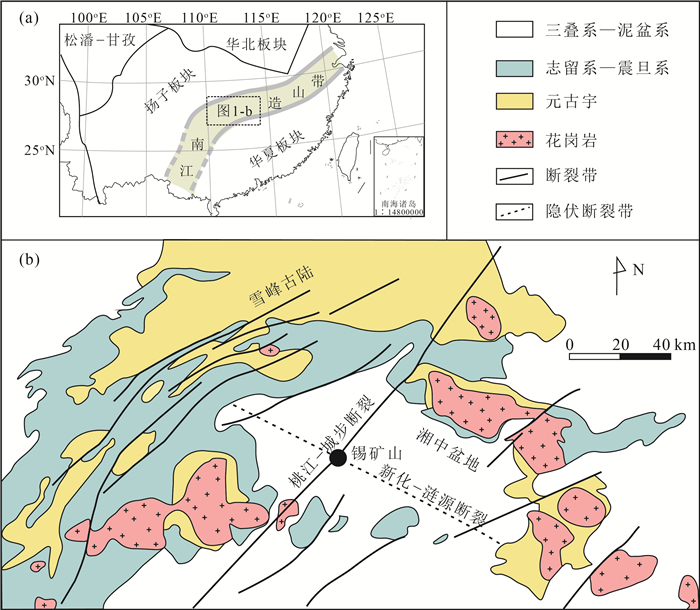
 下载:
下载:
